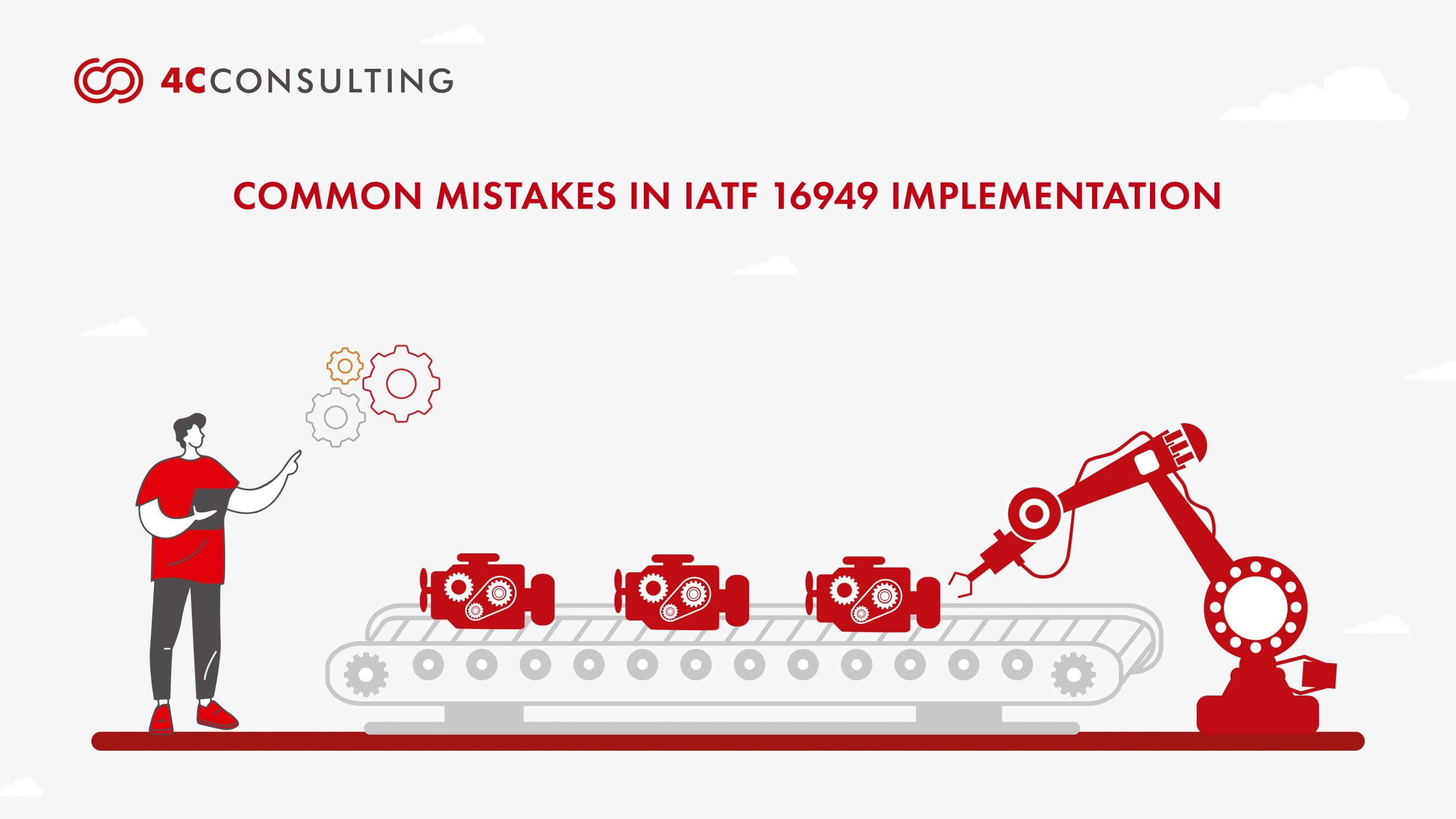
COMMON MISTAKES IN IATF 16949 IMPLEMENTATION AND HOW TO AVOID THEM
8th Nov, 2024
Did you know every 8 out of 10 automotive manufacturers face challenges during their IATF 16949 implementation? Achieving IATF 16949 certification is crucial for boosting quality management in the automotive sector, ensuring product reliability, and meeting customer expectations. However, the implementation process can be difficult, with many businesses making similar mistakes. This guide will highlight the most common errors companies make during IATF 16949 implementation and provide actionable solutions to ensure successful certification.
.
OVERVIEW OF IATF 16949 CERTIFICATION
IATF 16949 is an internationally recognized quality management standard designed specifically for the automotive industry. It provides a structured framework that helps organizations improve their processes, reduce defects, and ensure customer satisfaction. By adopting IATF 16949 standards, companies can not only achieve compliance with global automotive standards but also drive continuous improvement across their operations. However, improper implementation can result in non-conformities, increased operational costs, and missed opportunities for efficiency gains. Whether your organization is already certified or planning to achieve certification, understanding and avoiding common pitfalls is key to long-term success.
.
COMMON MISTAKES IN IATF 16949 IMPLEMENTATION
- Lack of Leadership Commitment: Successful IATF 16949 implementation starts with strong leadership. A common mistake is treating the certification process as solely the quality department’s responsibility rather than a company-wide initiative.
How to Avoid It: Ensure that top management is fully engaged in the process. Leadership should communicate the importance of IATF 16949 to the entire organization, allocate necessary resources, and actively participate in setting quality objectives. Engaged leadership fosters a culture of quality throughout the organization, which is required for effective implementation.
- Inadequate Employee Training: Employees who lack adequate IATF 16949 training often struggle to understand their role within the quality management system (QMS), leading to non-compliance and inefficient processes.
How to Avoid It: Provide regular, comprehensive training programs to ensure that all employees understand the standard, their responsibilities, and how they contribute to overall quality objectives. Training should be role-specific and include both classroom sessions and hands-on workshops to ensure practical knowledge.
- Neglecting Process Approach: IATF 16949 emphasizes a process approach to quality management. Businesses that fail to integrate their processes effectively may encounter inefficiencies and gaps in their QMS.
How to Avoid It: Adopt a systematic process approach by identifying and mapping all key processes. Understand how each process interacts with others, and use data to monitor and improve these processes continually. A well-defined process approach ensures consistency and helps achieve desired quality outcomes.
- Overemphasis on Documentation: While documentation is important for the IATF 16949 certification audit, excessive focus on paperwork without practical application can affect performance improvements.
How to Avoid It: Documentation should be used as a tool to enhance performance rather than as an end in itself. Focus on creating value-adding documents that help track progress, identify issues, and drive improvements. Ensure that the documented procedures are practical and integrated into daily operations.
- Skipping Internal Audits: Many businesses underestimate the importance of IATF 16949 internal audits and either skip them or conduct them superficially, resulting in undetected issues that can compromise certification.
How to Avoid It: Schedule regular internal audits conducted by trained internal auditors. These audits help identify non-conformities and provide opportunities for corrective actions before the external audit. Use internal audits as a tool for continuous improvement.
- Unclear Quality Objectives: Quality objectives that are not measurable lead to challenges in evaluating the effectiveness of the QMS.
How to Avoid It: Set SMART (Specific, Measurable, Achievable, Relevant, Time-bound) quality objectives that align with IATF 16949 requirements. These objectives should be clearly communicated across the organization, and progress should be monitored regularly to ensure continuous improvement.
- Lack of Supplier Involvement: Suppliers play a significant role in the automotive supply chain, and neglecting to involve them in the IATF 16949 implementation can lead to inconsistencies in product quality.
How to Avoid It: Establish clear communication with suppliers about quality expectations and involve them in the QMS. Conduct supplier evaluations and audits to ensure that they align with IATF 16949 requirements and actively contribute to your quality objectives.
- Insufficient Risk Management: Risk management is a critical part of IATF 16949. Companies often fail to conduct proper risk assessments, which leads to vulnerabilities in the production process.
How to Avoid It: Use tools such as Failure Mode and Effects Analysis (FMEA) to identify potential risks in processes, products, and the supply chain. Develop mitigation plans and integrate risk management into everyday practices to minimize disruptions and quality issues.
- Inadequate Resource Allocation: Failing to allocate sufficient resources—whether personnel, time, or finances are a frequent barrier to effective implementation.
How to Avoid It: Ensure that enough resources are dedicated to the IATF 16949 implementation process, including personnel, training, technology, and budget. Having adequate resources in place helps ensure that the QMS is effectively implemented and maintained.
- Ineffective Corrective Actions: When non-conformities are identified, inadequate root cause analysis often results in recurring issues, compromising the QMS.
How to Avoid It: When a non-conformity is identified, conduct a thorough root cause analysis to understand why it occurred. Develop a detailed corrective action plan to address the root cause, and verify its effectiveness to prevent recurrence. Effective corrective actions are key to improving the robustness of the QMS.
- Overlooking the Importance of Change Management: Changes within the organization, such as new processes or personnel shifts, can have a significant impact on the QMS. A common mistake is failing to manage these changes effectively.
How to Avoid It: Implement a structured change management process to assess the impact of changes on your QMS. Ensure that changes are documented, and training is provided where necessary. Regularly review changes to ensure they align with quality objectives and do not introduce new risks.
- Ignoring Customer-Specific Requirements: IATF 16949 standards also includes customer-specific requirements that must be met in addition to the standard’s guidelines. Companies sometimes overlook these requirements, leading to customer dissatisfaction.
How to Avoid It: Engage closely with customers to understand their specific requirements and ensure that these are incorporated into your QMS. Regularly review customer feedback and adjust processes to meet their expectations. Meeting customer-specific requirements helps enhance customer satisfaction and strengthens business relationships.
- Lack of Continual Improvement Focus: Some organizations treat IATF 16949 certification as a one-time achievement rather than an ongoing process. Without a focus on continual improvement, the benefits of the certification can quickly diminish.
How to Avoid It: Establish a culture of continual improvement by regularly reviewing processes, identifying areas for enhancement, and implementing corrective actions. Use data from audits, performance metrics, and customer feedback to drive improvements in your QMS.
.
BENEFITS OF HIRING AN IATF 16949 CONSULTANT
Hiring an experienced IATF 16949 consultant can make the implementation process more manageable and efficient. Consultants provide expert guidance, industry-specific solutions, and ensure that every requirement is thoroughly understood and met. Here are some benefits of hiring a consultant:
- Expert Guidance: Consultants bring a wealth of experience in IATF 16949 implementation, helping you navigate complexities and achieve certification smoothly. They provide tailored advice that aligns with your organization’s specific needs, ensuring that every step taken is effective.
- Process Optimization: They help identify inefficiencies in your processes and provide practical solutions to optimize them, improving overall productivity and product quality. This results in streamlined workflows and more efficient use of resources, ultimately boosting profitability.
- Employee Training and Awareness: Consultants can provide IATF 16949 training, ensuring that every team member understands their role within the QMS and contributes effectively. This empowers employees to actively participate in maintaining high standards of quality and compliance.
- Reduced Risk of Non-Conformities: By conducting internal audits and gap analyses, consultants help minimize the chances of non-conformities during the certification audit. Their expertise helps address potential issues before they escalate, saving time and avoiding disruptions during the audit.
- Timely Certification: Consultants streamline the entire process, helping you avoid delays and achieve certification in a timely manner. Their focused approach helps keep your project on track, reducing downtime and ensuring you are ready for market opportunities sooner.
Achieving IATF 16949 certification is an important step for automotive manufacturers aiming to enhance product quality, boost customer satisfaction, and maintain competitive standards. However, the implementation process comes with challenges that can lead noncompliance if not addressed properly. By understanding and avoiding common mistakes such as inadequate leadership commitment, insufficient employee training, and neglecting continual improvement, businesses can ensure a smoother path to certification. Engaging an experienced consultant can further facilitate the process, making it efficient, effective, and aligned with industry requirements. Proper planning, effective risk management, and an organization-wide commitment to quality are key to achieving IATF 16949 to its fullest potential.
.
WHY CHOOSE 4C CONSULTING TO CAN HELP YOU GET IATF CERTIFICATION?
Implementing IATF 16949 can be a complex journey, but 4C Consulting simplifies the process with over 15+ years of expertise in ISO consulting. Our team of experienced consultants and IRCA-certified auditors has successfully guided more than 3,000+ businesses across various industries, ensuring efficient IATF 16949 certifications. We provide comprehensive consultancy, training, and implementation services tailored to your specific needs, delivering over 30,000+ man-days of consulting and 20,000+ hours of training. 4C is equipped to guide your organization seamlessly through IATF 16949 implementation and certification 100+ TS/IATF Consulting projects successfully. Visit www.4cpl.com to initiate the journey towards enhanced automotive quality and regulatory compliance.
